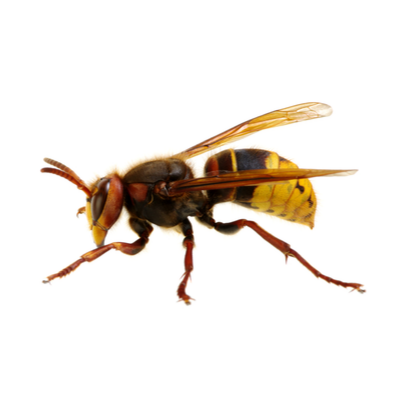Color: Black and ivory white markings on the face, thorax (middle body part) and tip of the abdomen.
Size: Bald-faced hornets are up to 3/4-inch long.
Hornets are social insects, living in colonies containing workers, queens and males. The nests resemble a large, inverted tear-drop shaped ball which typically is attached to a tree, bush or side of a building.
After eggs hatch, the queen feeds the young larvae. When larvae are ready to pupate, cells are covered with silk, forming little domes over the individual openings. Larvae pupate, emerging later as small, infertile females called "workers." By mid-June, the first adult workers emerge and assume the tasks of nest expansion, foraging for food, caring for the queen and larvae and defending the colony. With paper wasps, the nest is the work of a single female, has a single layer or "tier" of cells and is not enclosed by envelopes. In hornets, the nests usually consist of a number of stories or "tiers," one below the other and completely enclosed by spherical walls. Each cell may be used for two or three successive batches of brood.
Adult food consists of nectar or other sugary solutions such as honeydew and the juices of ripe fruits. Hornets also feed on bits of caterpillars or flies that are caught and partially chewed before presenting to their young. Hornets may be seen almost any summer day engaged in their winged pursuit of flies.
Hornets may become a nuisance when nesting around homes and other structures where people live, work or play. Although considered beneficial to agriculture, it is their painful stinging ability that causes alarm and fear. Nevertheless, unless the threat of stings and nest location present a hazard, it is often best to wait for Mother Nature to kill these annual colonies with freezing temperatures in late November and December. Stinging workers do not survive the winter, and the same nest usually is not reused the following year, except by the yellow and black dominulus paper wasp, on occasion.
Sting Prevention:
- Hornets have a lance-like stinger and can sting repeatedly. When a hornet is near you, slowly raise your hands to protect your face, remaining calm and stationary for a while and then move very slowly away. Never swing, strike or run rapidly away since quick movement often provokes attack and painful stings. Restrain children from throwing rocks or spraying nests with water. Avoid creating loud noises and disturbance near the nest.
- When outdoors, avoid the use of heavily scented soaps, shampoos, perfumes, colognes, after-shaves and cosmetics. Avoid shiny buckles and jewelry. Cover exposed skin and wear gray, white or tan rather than bright colors.
- Also, remember that if a hornet gets into the automobile while driving, never panic. It wants out of the car as much as you want it out. Slowly pull over off the road, and open the car windows and doors. Trying to remove or kill a paper wasp or hornet while the car is moving can result in accidents.
Treatment of Stings:
- After being stung, immediately apply a poultice of meat tenderizer to the wound. If the sting is not deep, this will break down the components of the sting fluid, reducing the pain.
- A commercial preparation such as a sting kill swab can be used. Antihistamine ointments and tablets taken orally appear effective in reducing sting reactions. Persons highly sensitive to stings should consider a desensitization program in an allergy clinic. Consult your physician about medical kits such as Ana-Kit, which contains antihistamine tablets and aqueous epinephrine (adrenalin) administered by injection, a tourniquet and sterile alcohol swabs for cleaning the injection site. Frequently, a bronchodilator material (inhaler) is needed.
- Hypersensitive persons should never be alone when outdoors at the peak season of wasp and hornet activity. If stung, help may be needed to start prompt emergency treatment measures. Medic Alert Tags can be purchased from Medic Alert Foundation, Box 1009, Turlock, California 95381-1009, Telephone: 209-668-3333.
Persons who are especially sensitive to stings should get several competitive cost estimates from reputable, licensed, professional pest control operators who have the experience, equipment and most effective insecticides to get the best job done.


























